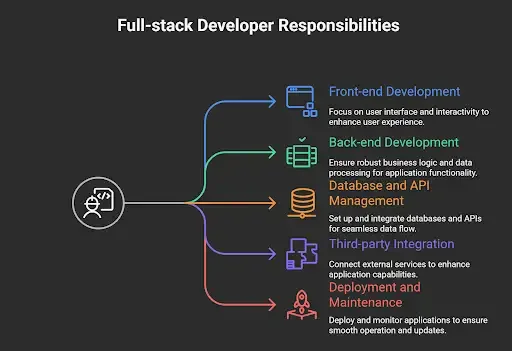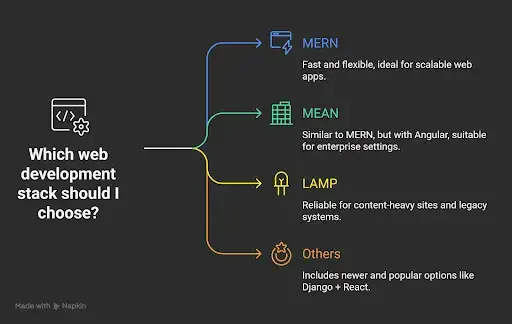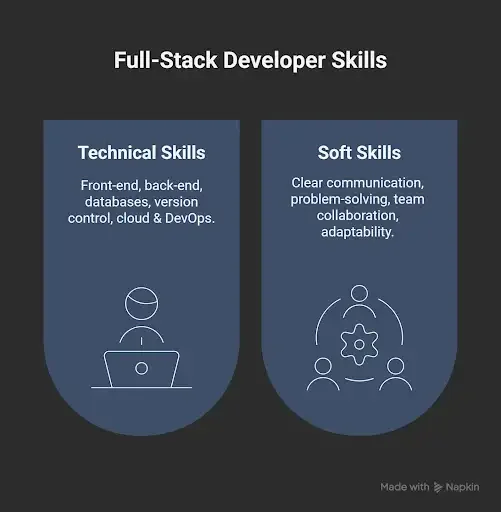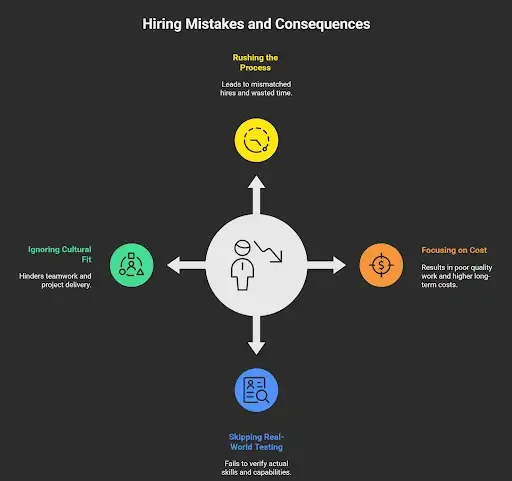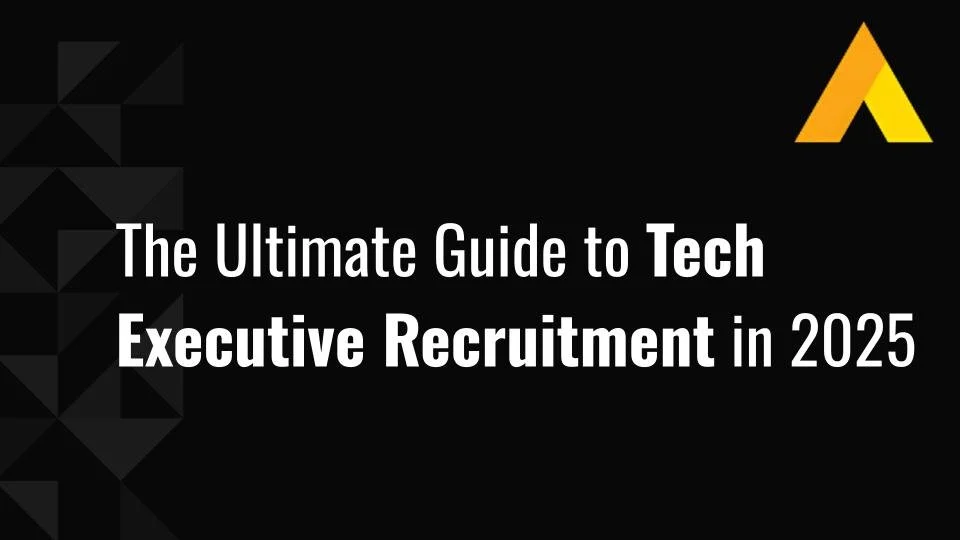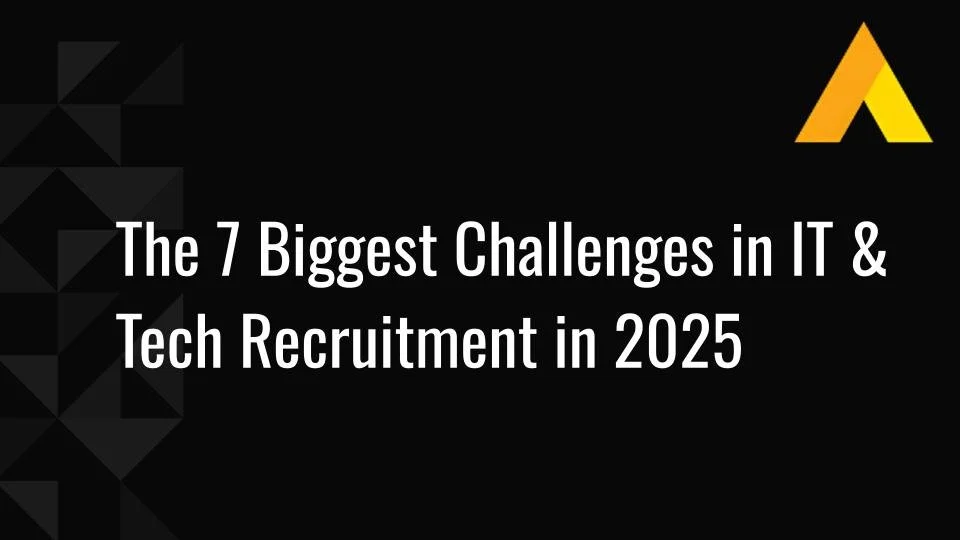How to Hire a Full-Stack Developer That Fits Your Team
Digital products fail for all sorts of reasons. One of the most common? Fragmented development teams and unclear ownership.
A strong full-stack developer can fix that.
They cover both the front and back end of your stack, work across systems, and keep your build moving without the friction that comes from managing too many roles at once. It’s no surprise companies are leaning into these versatile hires, especially as demand for efficient product delivery keeps rising.
Still, finding the right full-stack developer takes more than browsing GitHub or filtering by years of experience.
In this guide, we’ll break down how to hire a full-stack developer that actually fits your project, from defining your needs and budget to vetting technical skills and cultural fit.
Let’s take a look.
Pro tip: At Alpha Apex Group, we run full-stack developer recruitment and staffing services, so you only meet top full-stack candidates.
TL;DR
If you’re short on time, here’s the quick summary:
Full-stack developers handle both front-end and back-end; that’s why companies like to hire them.
Ideal for lean teams, MVPs, or projects with tight timelines and budgets.
Top technical skills: JavaScript, React, Node.js, SQL/NoSQL, Git, and cloud basics.
Soft skills matter too: look for strong communication, adaptability, and problem-solving.
Best platforms to find talent: LinkedIn, GitHub, Upwork, or specialized agencies.
Test real-world skills, not just resumes: use coding challenges and project reviews.
Freelancers = cost-efficient for short-term. Agencies = better for complex or long-term work.
Define your scope, stack, and budget before starting your hiring process.
Avoid rushing, lowballing, or skipping interviews. Bad hires are expensive.
What Exactly Does a Full-Stack Developer Do?
A great full-stack developer does more than just handle both front-end and back-end tasks. They take charge of entire features, building them from the ground up and making sure everything works seamlessly as the product grows and evolves.
Here’s what it looks like in practice.
Full-stack Developer Responsibilities
A solid full-stack dev should be able to:
Build both front-end and back-end applications: They write the code that runs in your user’s browser (UI, interactivity) and the logic behind the scenes (business logic, data processing).
Work with databases, APIs, and servers: They set up and query databases, create or integrate APIs, and configure servers to make your application run smoothly and securely.
Integrate third-party services: Think Stripe, Firebase, AWS, or internal APIs. Full-stack devs connect the dots and make these systems talk to each other.
Handle deployment and maintenance: Many of them also deploy and monitor apps post-launch, keeping updates flowing and bugs under control.
The real value is you don’t need to hire three separate people to get a feature out the door. You can move faster and reduce handoffs, which keeps progress up and costs down.
Popular Tech Stacks for Full-Stack Developers
Most full-stack devs specialize in specific tech stacks. Here are the most common:
MERN: (MongoDB, Express, React, Node.js) A JavaScript-powered stack that’s fast, flexible, and great for building scalable web apps.
MEAN: (MongoDB, Express, Angular, Node.js) Similar to MERN, but swaps React for Angular. Often used in enterprise settings.
LAMP: (Linux, Apache, MySQL, PHP/Python/Perl) An older, reliable stack still used for content-heavy sites and legacy systems.
Others: (Django + React, Ruby on Rails, .NET stacks…) These include other options that are more recent and popular now.
Choosing the right team starts with knowing what your project needs. Languages matter, but so do performance, scalability, and how quickly you need to launch.
Why Should You Hire a Full Stack Developer?
Full-stack developers aren’t the right fit for every situation. But, in the right context, they can really improve a team’s impact. That’s why startups, lean teams, and even bigger companies looking to simplify development and cut costs often turn to them.
Let’s get deeper into why:
Efficiency and Cost Savings
Here’s how hiring one full-stack dev can streamline your costs and speed:
One developer can build and connect both sides of your product.
Fewer people involved means less coordination, less miscommunication, and less delay.
You cut costs, but not just in salaries, also in time to market.
That’s why companies focused on efficiency are increasingly hiring full-stack devs to reduce the need for multiple roles.
Flexibility Across Project Phases
This is where full-stack developers shine in fast-changing environments:
They can jump between front-end, back-end, databases, and deployment without needing to switch roles or wait on others.
When requirements change mid-project, they adapt quickly and keep things moving without delays.
They reduce bottlenecks by connecting all parts of the stack, which helps teams ship updates faster.
Need to change features mid-sprint? A full-stack dev can adjust without waiting for separate team approvals.
Easier Project Management
Managing fewer people has clear upsides. Here’s what that looks like:
With fewer people involved, managing the project gets simpler.
Instead of syncing schedules between a front-end dev, a back-end dev, and a DevOps engineer, your PM works with one point of contact.
This reduces noise and keeps the project aligned.
Ideal for Startups and Lean Teams
If you're building with limited resources, these points matter most:
Startups don’t always have the runway to build full teams.
Full-stack devs help you build MVPs fast, test ideas, and pivot quickly.
That flexibility makes them one of the most common early hires in small teams and bootstrapped projects.
What Skills Should You Look for in a Full Stack Developer?
Full-stack developers bring different levels of value, and it goes beyond how well they code. You’re looking for people who can make an impact, move fast, and adapt as things change.
The best ones combine technical depth with clear communication and strong problem-solving skills. Let’s break that down.
Technical skills
Here’s what to expect on the hard skills side:
Front-end: HTML, CSS, JavaScript, and frameworks like React, Angular, or Vue. These shape what users see and interact with.
Back-end: Node.js, Python, Ruby, Java, or PHP. This is where your app’s core functionality lives.
Databases: Both SQL (like PostgreSQL, MySQL) and NoSQL (like MongoDB) knowledge is valuable.
Version control: Git is the standard. If they’re not using it, it’s a red flag.
Cloud & DevOps basics: Familiarity with AWS, Docker, or CI/CD tools helps them deploy faster and keep things stable.
P.S.: JavaScript (62%), HTML/CSS (53%), and Python (51%) are still the most-used languages among developers according to Stack Overflow’s 2024 survey. A solid full-stack dev should be fluent in at least two of those.
Soft skills
Now let’s talk about the non-technical side. A developer who struggles to communicate or work with others can end up slowing the whole team down.
Here’s what to look for:
Communication: They should explain ideas clearly and keep updates flowing without jargon walls.
Problem-solving: Great devs know how to troubleshoot and optimize without waiting for instructions.
Collaboration: Working solo or as part of a team, they need to stay in sync and be easy to collaborate with.
Adaptability: Projects evolve and tools change. Your developer should be able to adapt smoothly and keep things moving forward.
These soft skills are what make someone more than just a coder. They’re what make them an asset.
Pro tip: Need more details on how to hire a full-stack developer? Our ultimate guide to tech recruitment answers all your questions!
How Do You Define Your Hiring Needs Before Starting?
Before you look for a full-stack developer (be it posting a job, calling an agency, or reviewing portfolios), take a minute to define what you actually need. A rushed process leads to mismatches, and that costs time and money.
Start by getting clarity on four core areas:
Project scope: Are you building a quick MVP, a complex product, or just improving an existing system? Your answer shapes the type of developer you need.
Required tech stack & tools: Know what your product is built on, or what you want to build with. This helps filter candidates quickly.
Expected timeline: Is your timeline short-term or long-term? That will guide you toward hiring a freelancer, bringing someone on full-time, or working with an agency.
Budget considerations: Be honest about what you can afford. For reference, the average U.S. full-stack dev earns $69,453/ year, according to Salary.com. Rates can swing depending on seniority and location.
Defining this upfront keeps you focused during hiring. You won’t waste time chasing candidates who aren’t aligned with your actual needs.
Where Can You Find the Right Full Stack Developers?
Once you know what kind of dev you need, the next step is knowing where to look. There’s no shortage of platforms or hiring paths, but each has its pros and tradeoffs depending on your timeline, budget, and level of control.
Here’s a breakdown of the most effective sourcing options:
Job Boards and Professional Networks (LinkedIn, Indeed, Glassdoor)
If you're hiring in-house or want long-term team members, these are good places to start:
Post detailed job openings with your stack and scope.
Use filters and Boolean search to actively find candidates.
Works well for a wide reach and employer branding.
Just keep in mind: inbound applications on these platforms can be high-volume but low-signal. You’ll need a tight screening process.
Freelance Platforms (Upwork, Toptal, Fiverr Pro)
For project-based or short-term needs, freelance marketplaces give you fast access to global talent. On those sites:
You can filter by experience, hourly rate, and tech stack.
Great for MVPs, testing out a dev, or augmenting a current team.
Platforms like Toptal pre-vet candidates, which can speed things up.
If you go this route, vet portfolios and client reviews closely, especially if you’re hiring solo without agency support.
Developer Communities (GitHub, Stack Overflow, Reddit)
Looking for someone hands-on and engaged in their craft? Start here:
GitHub lets you see their actual code and project activity.
On Stack Overflow, check how they solve problems and contribute.
Subreddits like r/forhire or r/webdevjobs can surface niche talent fast.
This path requires more effort upfront, but it’s a powerful way to connect with talented developers who are genuinely invested in creating, and not just chasing their next gig.
Hiring Agencies / Outsourcing Firms
If you want someone else to handle the vetting and logistics, this is your lane:
Agencies have curated networks and fast turnaround.
Outsourcing firms can provide full teams, not just individuals.
This is especially useful when you need to scale quickly or don’t want to manage freelancers directly.
It’ll cost more, but for larger or ongoing projects, the time saved can justify the price.
How Do You Assess and Interview a Full Stack Developer?
Finding a full-stack developer is only part of the process. What matters is how well they can apply their skills in real scenarios.
Here’s how to structure your vetting process to separate talk from talent:
Resume Screening
Start with the basics:
Check for portfolio links, GitHub profiles, and shipped projects.
Look for experience with the stacks you actually use.
Bonus points for contributions to open-source or side projects.
Remember that effective hiring means prioritizing proven capabilities over polished resumes.
Pro Tip: Need a quicker, more in-depth way to screen candidates? Alpha Apex Group provides market-tested vetting and co-branded outreach campaigns across multiple job boards, giving you 3X the visibility and a shortlist of vetted full-stack candidates.
Technical Assessments
Impressive credentials mean little without the skills to back them up.
So test them:
Use coding tests, take-home challenges, or small trial tasks.
Focus on problem-solving and how they approach real-world situations.
Live coding interviews are useful, but don’t overdo it. They don’t replicate actual work environments.
Soft Skill Interviews
Technical skills get you to launch. Soft skills keep your team functional.
Ask how they handle blockers, team feedback, or changing requirements.
Strong candidates communicate with clarity and structure, not filler or technical clichés.
Pay attention to how they ask questions, too. It tells you how they think.
They may seem secondary, but soft skills are often what keep projects moving smoothly and teams working well together.
Red Flags to Watch Out For in a Full-Stack Developer
Some signals are easy to miss. Watch for these:
No portfolio or working demos.
Overuse of vague terminology (“tech-savvy,” “agile thinker”) with no examples.
Dodging feedback or getting defensive during the interview.
Inconsistent job history without clear explanations.
A single red flag can be discussed. A pattern of them shouldn’t be ignored.
Should You Hire Freelancers or an Agency?
Choosing between freelancers and agencies depends on your project’s complexity, your budget, and how much control you want over the process.
Both options work, but for different situations:
Pros and Cons of Freelancers
Here’s why freelancers might fit your project:
Pros: Flexible, cost-effective, and you get access to a wide global talent pool.
Cons: Reliability and availability can be inconsistent. If they get sick or take another project, delivery may stall.
Pros and Cons of Agencies or Outsourcing
Agencies and outsourcing firms can provide more structure overall:
Pros: Pre-vetted teams, faster onboarding, and scalable resources.
Cons: Higher cost and less direct control compared to working with an individual developer.
How to Choose what Fits Your Situation Best
Think about the scope. Small projects or quick MVPs can work well with freelancers. Larger, long-term, or complex builds usually need the structure of an agency team. Match the option to your budget, timeline, and product goals.
How Much Does It Cost to Hire a Full Stack Developer?
Cost is always a deciding factor. Salaries and rates vary widely depending on experience, location, and whether you’re hiring full-time or short-term.
According to data shared by Salary.com, here’s what you should expect:
Average salary in the U.S.: The average salary in the U.S. is $69,454 per year, with entry-level roles around $59,483 and top earners reaching +$79,000.
Freelancer hourly rates: Range from $20–$40 for juniors, $40–$70 for mid-level, and $70+ for seniors, depending on region.
Global differences: Rates in Asia and Eastern Europe are usually lower, while North America and Western Europe tend to cost more.
Hidden costs: Don’t forget onboarding, training, and benefits for full-time hires. These can add 20–30% on top of base salary.
The bottom line: Define your budget early and align it with the experience level you actually need. Hiring someone too junior to save money usually backfires when projects take longer or need costly rewrites.
Common Mistakes to Avoid When Hiring a Full Stack Developer
A poor hiring decision can lead to significant time and budget losses. Here are some common mistakes to avoid.
Rushing the process: Moving too fast leads to mismatched hires. Take the time to properly vet candidates.
Focusing only on cost: A cheaper hire who can’t deliver ends up costing more in the long run. Balance the budget with quality.
Skipping real-world testing: Resumes and flashy terms don’t prove execution. Always test skills through code reviews, projects, or assessments.
Ignoring cultural fit: A dev who can’t work well with your team will slow delivery, no matter how skilled they are.
Avoiding these pitfalls can save you time, money, and headaches down the line.
Pro tip: Looking to cut time-to-hire and avoid costly mistakes? Alpha Apex Group’s data-driven process has helped clients reduce appointment backlogs by over 20% and complete critical hires in as little as 43 days.
Ready to Hire a Full-Stack Developer? Here’s Your Next Step
Hiring a full-stack developer can give your team the speed and flexibility to build and scale without needing to bring on multiple people. But that only works if you make a thoughtful choice.
The right developer brings more than code to the table. They actively contribute to shaping the product and play a meaningful role as a partner in its direction.
If you do the right hiring process, you could find a developer who won’t just build your product, but will grow with it.
At Alpha Apex Group, we help businesses team up with vetted full-stack developers who can handle work at every stage of your project.
Contact us today and let’s find the right fit for your team.
FAQs
What kind of tasks can a full-stack developer handle day to day?
They cover end-to-end software development. This includes building web applications, working with front-end technologies and back-end development, managing database operations, creating or integrating RESTful APIs, handling user authentication, and ensuring smooth application development from start to finish.
What are the most important skills to look for in a full-stack developer?
A strong dev should be fluent in multiple programming languages (JavaScript, Python, etc.), experienced with both front-end and back-end technologies, and familiar with cloud platforms like AWS. They should also know how to design system architecture, run unit and integration testing, and handle database optimization for performance.
Should I hire a full-stack developer or a team of specialists?
For startups and lean teams, a single full-stack engineer can cover more ground with fewer hires. Larger tech companies or enterprises often prefer specialists or staff augmentation to scale faster. The right choice depends on your project’s complexity, timeline, and budget.
What’s the difference between a full-stack developer and a front-end/back-end developer?
A full-stack web developer or full-stack developer can handle both sides of full-stack software development. In contrast, front-end devs focus on building frontend dashboards and UI, while back-end devs work on database schema, logic, and back-end technologies.
How do I know if a full-stack developer is truly experienced?
Check more than a resume. Use a technical interview to validate their skills, review past job descriptions, and see how they’ve applied security implementation or worked with database management in real projects. A good recruitment process always includes practical tests.
Can a single full-stack developer handle an entire project on their own?
For smaller builds such as MVPs, yes. They can cover the operating system setup, design web components, manage API servers, configure HTML attributes, and optimize databases. For larger applications, additional roles (QA, DevOps, or UX designers) ensure better user experience, higher customer satisfaction, and stronger security needs.


